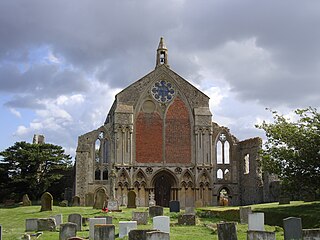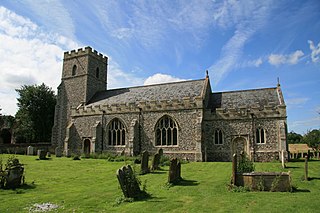Related Research Articles

St Olaves is a village in the English county of Norfolk. The village is situated on the River Waveney, 6 miles (10 km) south-west of the town of Great Yarmouth and the same distance north-west of the Suffolk town of Lowestoft. It is within The Broads national park.

Herringfleet is a place and former civil parish in the north of the English county of Suffolk. It is located 5.5 miles (8.9 km) north-west of Lowestoft in the East Suffolk district. The parish was combined with Somerleyton and Ashby to create the parish of Somerleyton, Ashby and Herringfleet in 1987.

Bromholm Priory was a Cluniac priory, situated in a coastal location near the village of Bacton, Norfolk, England

St Mary's Priory, Binham, or Binham Priory, is a ruined Benedictine priory located in the village of Binham in the English county of Norfolk. Today the nave of the much larger priory church has become the Church of St. Mary and the Holy Cross and is still used as a place of worship. The remains of the priory are in the care of English Heritage. The abbey's west face is the first example in England of gothic bar tracery, predating Westminster Abbey by a decade.

West Acre is a village and civil parish in the King's Lynn and West Norfolk district of the county of Norfolk, England. It covers an area of 14.49 km2 (5.59 sq mi) and had a population of 187 in 83 households at the 2001 census, the population increasing to 260 at the 2011 Census.

Upwell is a village and civil parish in the English county of Norfolk. Upwell village is on the A1101 road, as is Outwell, its conjoined village at the north. The nearest towns are Wisbech to the north-west and Downham Market to the east.
Axholme Charterhouse or Axholme Priory, also Melwood Priory or Low Melwood Priory, North Lincolnshire, is one of the ten medieval Carthusian houses (charterhouses) in England. It was established in 1397/1398 by Thomas Mowbray, Earl of Nottingham and later Duke of Norfolk. The house was centred on a pre-existing chapel on the present Low Melwood Farm, between Owston Ferry and Epworth in the Isle of Axholme, which according to a papal bull of 1398 "was called anciently the Priory of the Wood".

Rumburgh is a village and civil parish in the English county of Suffolk. It is 3.5 miles (5.6 km) north-east of the market town of Halesworth in the East Suffolk District. The population of the parish at the 2011 United Kingdom census was 327.
Horstead Priory was a Benedictine Alien house in Norfolk, England.

The Priory of St Mary de Bello Loco, commonly referred to as Molycourt Priory, was a small Benedictine priory located in the parish of Outwell, Norfolk, England.

Old Buckenham Priory was an Augustinian priory built on the site of Old Buckenham Castle at Old Buckenham in Norfolk, England.

Pentney Priory was an Augustinian priory at Pentney in the district of King's Lynn and West Norfolk, Norfolk, England. The ruins of the priory, mostly comprising the flint-built gatehouse, are Grade I listed.
Welle Priory was a priory in Gayton, in Norfolk, England.
Toft Monks Priory was a priory at Toft Monks, Beccles, Norfolk, England. It included St Margarets, Toft Monks and St Mary, Haddiscoe

Weybourne Priory was a small Augustinian medieval monastic house in Weybourne, Norfolk, England.
Witchingham Priory was a priory in Norfolk, England.

Rumburgh Priory was a Benedictine priory located in the village of Rumburgh in the English county of Suffolk. The priory was founded in about 1065 as a cell of St Benet's Abbey at Hulme in Norfolk. At the time of the Domesday Book in 1086 it had 12 monks. The ownership of the priory was transferred to St Mary's Abbey in York towards the end of the 12th century. The monks of Rumburgh were particularly devoted to St. Bee, whom they commemorated at Michaelmas.
Snape Priory was a priory in Suffolk, England. It was founded as a cell of the Benedictine St John's Abbey, Colchester in Essex.
References
- 1 2 3 Page, William (1906). History of the County of Norfolk: Volume 2. London: Victoria County History.
- ↑ "Heritage Gateway - Results". www.heritagegateway.org.uk. Retrieved 30 April 2022.